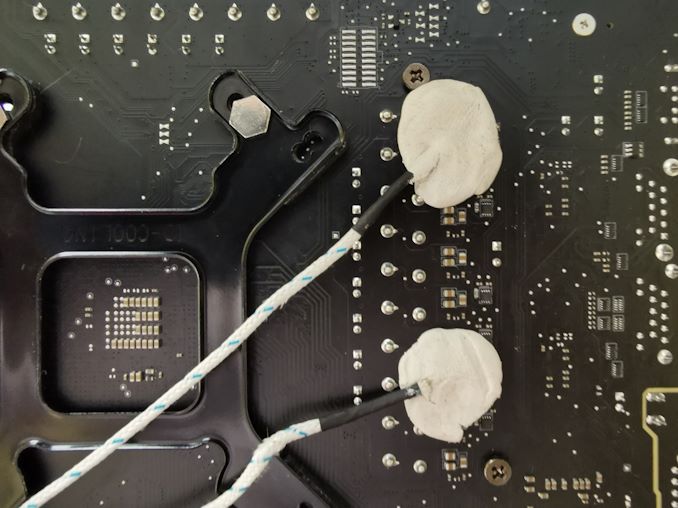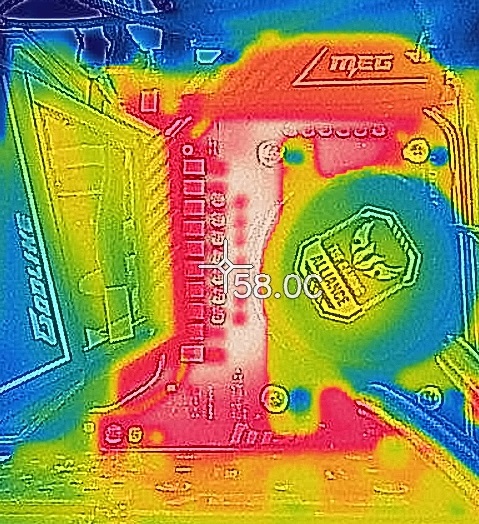The MSI MEG X570 Godlike Motherboard Review: Thor's Flagship
by Gavin Bonshor on August 28, 2019 12:00 PM EST- Posted in
- Motherboards
- AMD
- MSI
- 10G Ethernet
- Ryzen
- PCIe 4.0
- Ryzen 3000
- X570
- X570 Godlike
- MEG
Power Delivery Thermal Analysis
One of the most requested elements of our motherboard reviews revolves around the power delivery and its componentry. Aside from the quality of the components and its capability for overclocking to push out higher clock speeds which in turn improves performance, is the thermal capability of the cooling solutions implemented by manufacturers. While almost always fine for users running processors at default settings, the cooling capability of the VRMs isn't something that users should worry too much about, but for those looking to squeeze out extra performance from the CPU via overclocking, this puts extra pressure on the power delivery and in turn, generates extra heat. This is why more premium models often include heatsinks on its models with better cooling designs, heftier chunks of metal, and in some cases, even with water blocks such as the ASUS ROG Crosshair VIII Formula.

Two K-Type Thermal Probes attached to the rear of the power delivery on the MSI MEG X570 Godlike
Testing Methodology
Out method of testing out if the power delivery and its heatsink are effective at dissipating heat, is by running an intensely heavy CPU workload for a prolonged method of time. We apply an overclock which is deemed safe and at the maximum that the silicon on our AMD Ryzen 7 3700X processor allows. We then run the Prime95 with AVX2 enabled under a torture test for an hour at the maximum stable overclock we can which puts insane pressure on the processor. We collect our data via three different methods which include the following:
- Taking a thermal image from a birds-eye view after an hour with a Flir Pro thermal imaging camera
- Securing two probes on to the rear of the PCB, right underneath CPU VCore section of the power delivery for better parity in case a probe reports a faulty reading
- Taking a reading of the VRM temperature from the sensor reading within the HWInfo monitoring application
The reason for using three different methods is that some sensors can read inaccurate temperatures, which can give very erratic results for users looking to gauge whether an overclock is too much pressure for the power delivery handle. With using a probe on the rear, it can also show the efficiency of the power stages and heatsinks as a wide margin between the probe and sensor temperature can show that the heatsink is dissipating heat and that the design is working, or that the internal sensor is massively wrong. To ensure our probe was accurate prior to testing, I personally binned 10 and selected the most accurate (within 1c of the actual temperature) for better parity in our testing.
For thermal image, we use a Flir One camera as it gives a good indication of where the heat is generated around the socket area, as some designs use different configurations and an evenly spread power delivery with good components will usually generate less heat. Manufacturers who use inefficient heatsinks and cheap out on power delivery components should run hotter than those who have invested. Of course, a $700 flagship motherboard is likely to outperform a cheaper $100 model under the same testing conditions, but it is still worth testing to see which vendors are doing things correctly.
Thermal Analysis Results

We measured 58°C on PCB between the CPU socket and power delivery
The MSI MEG X570 Godlike is running a 14-phase design for the CPU VCore section. This includes an International Rectifier IR35201 running in a 7+1 configuration with seven IR3599 doublers on the rear of the PCB; the SoC section is running four phases off a single IR3599 which splits the signal into four. As far as designs go, this is MSI's best AMD power delivery that I can recall seeing, although I still find it a little odd that the SoC section is split into four, but through one IR3599 doubler in quad mode. Perhaps this will yield some benefits and gains for extreme overclockers, but it's not an issue for general users to be concerned about. The heatsink is very similar to the MSI MEG X570 Ace and uses the same design. The power delivery heatsinks are interconnected by a heat pipe which stretches around the left side of the memory slots and down into the actively cooled X570 chipset heatsink.
As we get more results, we will endeavour to update this chart when more models have been tested
Note - The ASRock B450 Gaming ITX-ac model crashed instantly every time the small FFT torture test within Prime95 was initiated. At anything on the CPU VCore above 1.35 V would result in instant instability. The Ryzen Master auto-overclocking function failed every time it tried to dial in settings, but it does however operate absolutely fine at stock, and with Precision Boost Overdrive enabled. Either the firmware is the issue, or the board just isn't capable of overclocking the Ryzen 3700X with extreme workloads with what is considered a stable overclock on the X570 chipset. We will re-test this in the future.
The power delivery on the MSI MEG X570 Godlike actually runs slightly cooler in our testing which can be explained by having a slightly better 14+4 power delivery versus the 12+2 design on the MSI MEG X570 Ace. More phases usually generate less heat overall as each phase is active for a shorter period of time, which does show in our testing. We ran our AMD Ryzen 7 3700X testbed sample at 4.1 GHz with a CPU VCore of 1.45 V which is consistent with other models we have tested to try and generate as much heat as possible. The power delivery probe output reading was 59°C after an hour of testing, while the VRM temperature sensor gave us a reading of 61°C. The MSI MEG X570 Godlike does well under our testing method and there should be no issues when overclocking the current Ryzen 3000 processors, as we found that we hit CPU thermal limitations before anything else.











116 Comments
View All Comments
inighthawki - Wednesday, August 28, 2019 - link
The CPU is still quite often the bottleneck for games when running at high framerates.goatfajitas - Wednesday, August 28, 2019 - link
Possibly if you bought an $800 VC and have a mediocre $200 CPU, but that isnt realistically what anyone would have bought.inighthawki - Wednesday, August 28, 2019 - link
That's just not true. Go play a game at 720p on lowest settings and you'll very quickly see that even high end CPUs produce a noticeable bottleneck for achieving high framerates.The numbers are available to you as well. You can very easily go to Anandtech's bench numbers and compare any two high end CPUs and still see a difference in framerate across many games using the same GPU, even on medium to high settings. It's typically also quite apparent in the 95th percentile metrics.
Sure if the game is poorly optimized and doesn't offer enough control over graphics settings to reduce the GPU load enough, you won't see much of a difference because of course the GPU will remain the bottleneck in those cases. However if you're shooting for high framerates like 240hz, the CPU is almost always the bottleneck.
Qasar - Thursday, August 29, 2019 - link
inighthawki um, who would pay $800 for a vid card, and play games at 720P on the lowest settings, regardless what cpu you are running ? that could be done with a $400 vid card depending on the gameinighthawki - Thursday, August 29, 2019 - link
Because not all games are well optimized and can require a strong GPU to hit very high framerates even on low settings. Even with top of the line hardware (both CPU+GPU) on lowest settings, many games cant even hit a stable 144hz.Qasar - Friday, August 30, 2019 - link
i never understood the reason for needing high frame rates with games.. i have played a few of the games i have over the years with new hardware, and been able to get better FPS, and maybe its just me, but i dont notice the difference. inighthawki " many games cant even hit a stable 144hz. " and what does a refresh rate have to do with frames per second ?? my lowly 75hz monitor works just fine when the games i play are above 75 fps or hz29a - Friday, August 30, 2019 - link
Low (<60 fps) framerates give me nausea.Qasar - Friday, August 30, 2019 - link
29a, then i guess you cant play many console games :-) the games i play, even with the eye candy on max, less AA and AF, rarely go below 75 fps on the current hardware i have :-)inighthawki - Friday, August 30, 2019 - link
>> and what does a refresh rate have to do with frames per second ??Just my poor phrasing because I'm typing quickly. I mean that they cannot maintain 144fps on my 144hz display.
Perhaps you dont play any games where it makes a significant difference, but for a lot of games once you play at 144hz, playing on a 60hz display is like watching a slideshow. Playing over 75fps on your 75hz display may improve input latency for your game but it wont be any smoother.
Qasar - Friday, August 30, 2019 - link
inighthawki on the contrary, it is noticeably smoother, enough where i notice, and turn a few of the eye candy options down a little if it does look choppy. but i have tried playing a few games on monitors like that, and while it is nice.. not something i am after right now.. but as you mentioned.. could be cause of the games i play, dont need it.. i assume, then, you play a lot of 1st person shooters ?